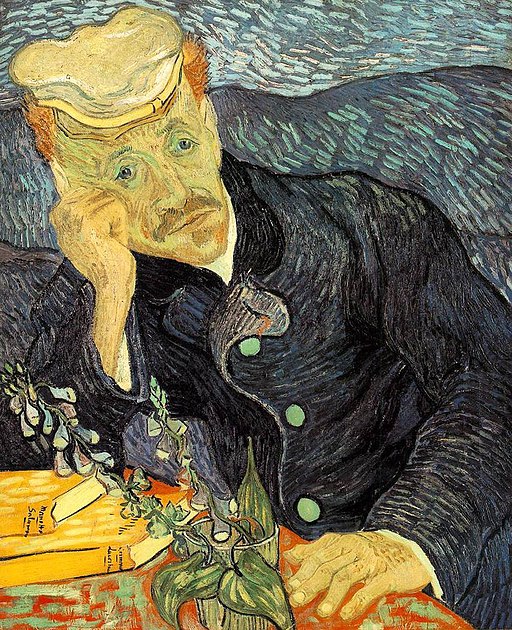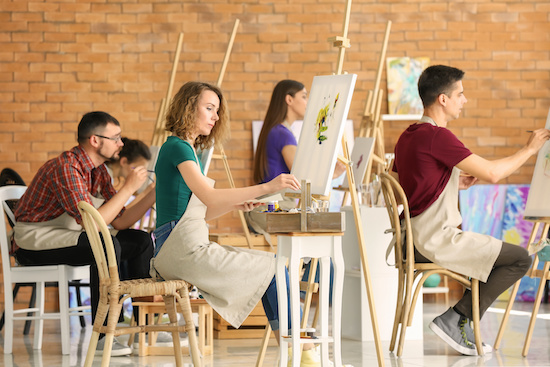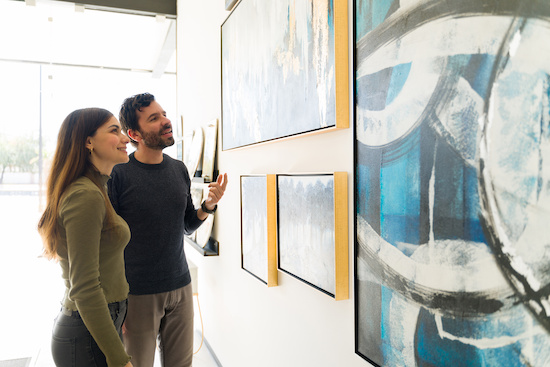How much money does an artist make? You shouldn’t apologize for wondering. Like any career, art needs to provide you a decent living. But becoming a successful artist means more than mastering your chosen medium. You need to build an art business. That requires goals, business plans and financial targets. Success means exhibiting, promoting and ultimately selling your work to a wide range of collectors. Only then will you have the freedom to make a career from your art.
Business plans, targets and goals might seem like creativity-killers. But if you want to make it in the artworld, you need to understand how to build an audience for your work. Then, once you have it, you need to learn how to grow it.
Sales are one important yardstick for becoming a successful artist. But you also need other long-term goals that you should aim for in your artistic career to measure if you’ve made it.
How much money can I make as an artist?
First things first. “How much money can I make?” is not a dirty question! Art is a labor of love, but nobody wants to starve in a garret for their artwork. While we love stories of artwork selling for millions, the average artist scrapes a living. In the US, the average income for a full-time fine artist is $60,000.
History is littered with romantic stories of artists who created masterpieces and lived in obscurity. Only after death does their work sell for millions at auction. Vincent van Gogh did sell a handful of paintings, including one to his brother. But he mostly swapped them for food. His most expensive painting, Portrait of Dr Paul Gachet, sold for $83 million in 1990. If we could ask Vincent van Gogh if he would prefer posthumous fame or a dignified living, he might have settled for modest success.
To be a successful artist you need to build a business plan. Winging it, no matter how talented you are, may still mean supplementing your income by serving up coffee.

How much is your art work worth?
Popularity and box office receipts will influence how much an actor is paid for a movie, and the artworld is not much different. The artworld relies on supply and demand. Put simply, how much work is there and does anybody want it? Correctly pricing your work shows that you value your work, first and foremost. This might mean fewer sales, but selling 200 paintings for £50 each will make the same amount as selling 10 works of art for £1,000. And there is more profit since there are less materials involved. Limit the supply and it can increase demand.
Collectors want to know if your work is an investment. Will your work hold its value? When assessing whether their clients should invest in an artist’s work, art advisers will consider whether the artist has secondary market potential and has sold well at auction. As with sponsoring museum shows, not all dealers will have the means to underwrite their artists and inflate the value of their work by purchasing any works that are offered at auction. But patrons and collectors of your work might be willing to do so, particularly if it is offered for sale in charity auctions benefiting causes they support. Taking advantage of those networks could buoy the long-term value of your art.
Make money from all of your art skills
Only a third of artists make all their money from selling work. So consider how you can add to your income and increase your visibility in the art world as well as gain those all-important networking opportunities. Most artists supplement their income with teaching or other associated professions. There are also plenty of income-generating opportunities such as public commissions, grants and artist’s residencies.
Find out more on our blog Beyond Creation: Other Careers in the Artworld
Set up your own art class to boost your visibility
Teaching is probably one of the most common side jobs for an artist. But it doesn’t have to be in a formal setting or classroom. Start by setting up your own short teaching course or class aimed at hobbyists who happily spend money on something they love. Teaching your own course without providing a set syllabus to achieve a qualification means students measure the success based on how much they enjoyed it.
As an artist, I’ve offered a number of ten-week beginner classes in painting and with a few flyers and free snippets in local papers and online, I having always filled the spaces. Consider where you can hold classes, the maximum number of students you can accommodate and how you can promote it – flyers, online or local newspaper listings. If the class sells out, take that as a vote of confidence and simply offer another one. Your syllabus should reflect what you know and should be tailored to the right level for your students, based on age, experience and motivation. Be prepared to alter your plan and get feedback on how the course is going from students to help improve as you go. Finally, don’t rule out a bit of recon: consider joining a similar class yourself to see how someone else does it (and how much they charge).
Discover more about how to set up a teaching class here: Art Courses – taking ’em and teaching ’em

Get an artist’s residency to earn money and build your CV
Residency programmes often target young or emerging artists, providing them with financial support and the space (both physical and mental) to explore new ideas.
There are a huge number of residencies available worldwide, with many designed to allow artists to experience the life and culture of other countries at the same time as developing their practice.
Undertaking a residency not only allows you to grow professionally. It may also allow you to expand your network in a new city or country. Some may also provide you with the opportunity to exhibit the work that you create during your residency in a solo show or cultural institution, which adds interest and depth to your artist bio. The pay will often by quite modest, but its value to your CV and your development as an artist is priceless. Organizations like Res Artis list global opportunities. While it is membership-based, you can access the open call residencies for free.
Go solo with your own exhibition to move your career forward
Many artists are building highly successful businesses selling directly to clients via their website, social media, or at artist-run fairs. Developing a relationship with a commercial gallery can, however, attract new clients, and provide a stimulus for previous customers to become repeat buyers.
More importantly, a solo show acts as a signal that gallerists have enough confidence in your work to invest in you as an artist, and to take the financial risk that solo exhibitions entail. Solo shows can also provide an opportunity for media coverage, and perhaps bring your work to the attention of curators, as well as collectors.
Get press coverage
Press coverage, whether in print or online, advertises your work to a wider audience. It might lead to a greater following on social media, and raise your profile among galleries, critics and potential buyers. It’s a good idea to keep track of media coverage via links to online articles on your website, but be wary of reproducing scans of print publications without their permission to avoid copyright issues.
If you are exhibiting at an art fair or in an open studio, display a book of press cuttings. Media coverage can not only give potential clients an insight into your work, but also instill them with the confidence to commit to a purchase. Every piece of marketing brings you closer to becoming a successful artist.
See our insider blog on How to publicize your art: seven different tricks

Exhibit in a public gallery or institution
On the road to becoming a successful artist, open exhibitions are a good starting point to get your work noticed. Open events start with small local town hall shows, but many take place in prestigious public galleries, museums and institutes. Not only do they bring a wide audience, but artists can be discovered here.
In fact, galleries use their open exhibitions to refresh their talent pool and often offer a solo exhibition as a prize. So keep an eye out for open show applications or sign up to an organization that will send you alerts. These shows can be competitive, attracting thousands of entries for only a hundred spaces, so research which ones are worth the effort.
Carefully read their eligibility criterion, as some may have geographical limitations or only accept certain mediums. View work shown in previous exhibitions to ensure this is the right show for you. A quick search online of open art exhibitions in 2023 brought up hundreds of listings and calls for applications. Once you receive an acceptance, attend the open nights and work the room. Your presence is as important as your art if you are serious about becoming a successful artist.
Gaining a spot on the walls or floor space at a major public institution demonstrates the value of your work by giving it that all-important artworld stamp of approval. And that brings us nicely to the next landmark in your career…
Win an art prize
In addition to the financial rewards that art prizes offer, being shortlisted for or awarded an art prize is a prestigious addition to your CV, and again can provide confidence in collectors to invest in your work.
And once you win, the benefits continue to snowball. Many competitions display shortlisted entries in public galleries, offering a route to exhibitions. When researching opportunities, bear in mind that some international competitions (such as the United States’ Birds in Art) are open to artists worldwide, and could potentially bring your work to new markets.
Give your artwork to public collections
Selectively giving away your art for free can be a great long-term investment. Donating a work of art to a public institution means adding them to your list of collectors. That roster of those who own your art is one of the key markers of an artist’s success and gets you closer to your aim to become a successful artist. Cultural importance means not only exhibiting in a public institution, but also having work in a public collection.
Although some public institutions do have the budget to purchase contemporary art, many might accept donations that fit well with their collections. If you can afford to donate a work to one or more institutions, take time to research those that might match your artistic style. If a gallery represents you, enlist them to approach curators on your behalf. A word of caution here: make sure they want it. You don’t want it returned, or worse, disposed of by the recipient.
Finally, if you want to make your artwork valuable, the one sure way is through death. It makes your work finite, brings publicity and makes collectors, exhibitors and academics review work. This means like Picasso, Monet, Matisse and poor Vincent van Gogh, someone else many years later will reap the real financial rewards of your talent. Becoming a succesful artist has its costs.
About the writer
Carol Burns is a journalist, editor and arts writer, who also has a thriving art practice. Based in Cornwall, U.K., she holds a BA and Master’s degree in Fine Art.
For aspiring and professional artists on the internets






